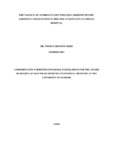Prevalence Of Anthracycline Induced Cardiomyopathy Amongst Cancer Patients Treated At Kenyatta National Hospital
Abstract
Background Cardiovascular complication is a major consequence of cancer treatment.Anthracycline induced cardiomyopathy is a known cause of long term morbidity and mortality among patients withcancer surviving chemotherapy. The burden of this disease in our population has not been well established and there is paucity of published data regarding the prevalence in the African setting. Objectives This study aimed to determine the prevalence of cardiomyopathy in patients at Kenyatta National Hospital who have been treated with anthracycline chemotherapy (Ac) and are on follow up by using a two dimensional (2D) ECHO. Methodology
It was a cross-sectional, descriptive study carried out at Kenyatta National Hospital. The study population included patients who had been exposed to Ac. The minimum Ac dose was 200mg/m2. A total of 129 patients with various types of cancers were sampled consecutively over a period of 3 months. Eligible patients underwent a 2D ECHOand left ventricular ejection fraction (LVEF) was assessed. Results Patients between the ages of 15 and 75 participated in the study, the mean age was 45.6 years, with the female to male ratio of 4.3:1. Majority of the patients had breast cancer (67.4%) andthe treatment regimen in over 65% of them was doxorubicin and cyclophospomide (AC). The mean cumulative dose was 236mg/m2. All patients recruited had received a cumulative dose of between200 - 450mg/m2. Most of the patients (63%) had completed Ac withinone year of their cardiac evaluation. Only 14.0 % of the patients had a pretreatment ECHO. The overall prevalence of LV systolic dysfunction detected by echocardiography was 3.1% (95% CI 0.9– 7.8).The study was not powered to make associations with age, sex and cumulative dose and presence of cardiomyopathy.
xi
Conclusion The study demonstrates a prevalence of 3.1% cardiomyopathy among cancer patients treated with anthracyclines. This figure is comparable to similar studies done. The prevalence described in most studies ranges from between 1% to 20.5%.
Publisher
University of Nairobi
Rights
Attribution-NonCommercial-NoDerivs 3.0 United StatesUsage Rights
http://creativecommons.org/licenses/by-nc-nd/3.0/us/Collections
The following license files are associated with this item:


